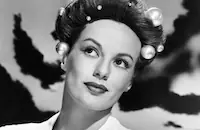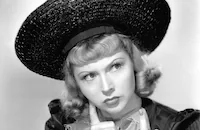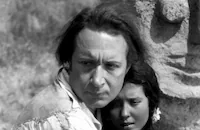Danger Signal

Brief Synopsis
Cast & Crew
Robert Florey
Faye Emerson
Zachary Scott
Dick Erdman
Rosemary Decamp
Bruce Bennett
Film Details
Technical Specs

Synopsis
When Alice Turner is found dead in her room, her landlady is stunned to learn that the man with whom Alice has been living is not her husband. Although Alice's death is ruled a suicide, Thomas Turner, her real husband, is convinced that she was murdered. Meanwhile, Ronnie Marsh, as the other man now calls himself, moves to another town and rents a room from Hilda Fenchurch, a stenographer, and her mother. The women eagerly await the return of Anne, Hilda's younger sister, who has been away. The charming Ronnie tells the Fenchurches that he is a struggling writer, and he and Hilda rapidly become friends. During a weekend away, for which Hilda is footing the bill, Ronnie presents her with the wedding ring he removed from Alice's dead finger. He tells her that the ring belonged to his mother and offers it to her as an engagement ring. Hilda's happiness is threatened after Anne returns home, however. Learning that Anne has inherited $25,000, Ronnie switches his interest to the younger woman and assuages her guilt by insisting that he has never been in love with Hilda. Meanwhile, Hilda has begun to think that Ronnie is not what he seems. She finds a gun in his room and then learns that he has taken Anne dancing. Ronnie dismisses her concerns and tricks her into writing a suicide note by pretending he needs help with a story. Hilda's suspicions are aroused again when Anne's old boyfriend, Bunkie Taylor, tells her that Anne and Ronnie have been dating regularly and that Ronnie has been paying for the dates with money he earned from selling his stories. Furious, Hilda asks Ronnie to leave the house, but Ronnie responds that if he leaves, Anne will leave with him. For help, Hilda turns to one of her clients, psychiatrist Dr. Jane Silla, who meets with Ronnie and agrees that he is dangerous. Ronnie's plan to kill Hilda is interrupted when Dr. Andrew Lang, another of Hilda's clients, unexpectedly asks for Hilda's help in his laboratory one evening. There Hilda finds a test tube filled with the deadly botulism bacillus and steals it. Pretending to be Silla, Hilda invites Ronnie to the psychiatrist's beach house for dinner. When Lang tells Silla that he has discovered the missing test tube, the two rush to the beach house, hoping to prevent Hilda from committing murder. After dinner, Hilda tells Ronnie that she has poisoned him, and he becomes wildly agitated, but the two doctors arrive in time to reveal that the test tube was never opened. Exposed as a coward, Ronnie starts to leave, but Turner, who has tracked Ronnie, chases him until he dies in a fall. Later, Anne is reconciled with Bunkie, who has joined the Navy, and Lang finally gets up the nerve to invite Hilda to a concert.

Director

Robert Florey
Cast

Faye Emerson

Zachary Scott
Dick Erdman

Rosemary Decamp

Bruce Bennett

Mona Freeman

John Ridgeley
Mary Servoss

Joyce Compton
Virginia Sale

Addison Richards

Howard Mitchell
Jack Smart
Clancy Cooper

Robert Arthur

Monte Blue
James Notaro
Crew
Gerald W. Alexander
Milo Anderson
Graham Baker
Harry Barndollar
Everett Brown
Adele Commandini
Murray Cutter
Jack Daniels
Adolph Deutsch
Edwin Du Par
Stanley Fleischer
Leo F. Forbstein
Charles David Forrest
James Wong Howe
William Jacobs
Ted Landon
Vernon Larson
James Leicester
Frank Magee
Jack Mcconaghy
Bertram Tuttle
Jack L. Warner
Robert G. Wayne
Perc Westmore

Film Details
Technical Specs

Articles
Danger Signal
As Ronnie Mason, Scott plays a ne'er-do-well writer who is on the run from the police. Seen fleeing the scene of a possible murder, Mason escapes to Los Angeles where, under an assumed name, he finds refuge as a boarder in the Fenchurch household. Spinning a web of lies, Mason quickly charms both the landlady, Mrs. Fenchurch (Mary Servoss), and her daughter, Hilda (Faye Emerson), who finds herself falling in love with this stranger in her home. Predictably, Mason and Hilda begin dating but their romance is interrupted by a visit from Hilda's younger sister, Anne (Mona Freeman). Once Mason learns that Anne stands to inherit a large inheritance when she marries, he promptly dumps Hilda and begins squiring her teenage sister around town. But Hilda WON'T BE IGNORED and is soon shopping for botulism test samples at Dr. Lang's laboratory, where she works as a stenographer. It's that one special ingredient that's needed to make her farewell dinner to Mason a memorable event.
Although you could argue that Danger Signal is really Hilda's story, it's Scott's entertaining performance as the amoral Mason that dominates the film. From the smug look on his face as he watches his evil schemes fall into place to the undisguised glee he registers as the two sisters engage in a jealous rivalry for his affections, Scott has no peer when it comes to playing a smarmy seducer like Mason. The film is equally fascinating for its mixture of film noir techniques (James Wong Howe's atmospheric cinematography), psychological profiling (the introduction of female psychiatrist, Dr. Silla (Rosemary DeCamp), who tries to analyze Mason's character), and a not-so-subtle subtext about male-female relationships - that women prefer aggressive go-getters like Mason to decent but ordinary Joes like Anne's teenage beau, Bunkie Taylor (Richard Erdman). The absurdly happy ending spells it all out for us as Hilda's formerly Milquetoast boss, Dr. Lang (Bruce Bennett), turns assertive and demands that Hilda accompany him on a date, after missing his chance many times before because of his own reticent nature.
Danger Signal was directed by Robert Florey, who helmed such well regarded genre efforts as Murders in the Rue Morgue (1932) and The Face Behind the Mask (1941). Valued for his technical skill and quick turnaround time on projects, Florey was a master at turning out superior B-pictures and, as a result, Warner Bros. rarely gave him an opportunity to graduate to A-pictures. In the case of Danger Signal, he ran into some unexpected problems. For one thing, the Hays Office (Hollywood's own censorship organization) demanded that the film's ending - where Hilda poisons Mason - be changed. In fact, five years earlier the Hays Office had initially rejected a film treatment of Phyllis Bottome's original story as morally objectionable and it took more than twenty-five writers before the film finally reached the screen. Additional production delays were caused by the replacement of Ann Blyth, due to a back injury, in the role of Anne Fenchurch.
According to co-star Rosemary DeCamp, who cites Danger Signal as one of her favorite screen roles in Femme Noir: Bad Girls of Film by Karen Burroughs Hannsberry (McFarland & Company), Faye Emerson's engagement during the production to Brigadier General Elliott Roosevelt (the son of President Franklin D. Roosevelt) also caused delays: "Every time [Elliott] flew over the sound stage we all had to turn out and wave, falling behind day after day. Then they - Faye and Elliott - went to Arizona for their wedding, adding another four days to the schedule. When filming resumed, our fabulous cinematographer, Jimmy Wong Howe, said he couldn't repair the honeymoon damage and Faye's face had to have a rest. Finally, we had almost caught up when President Roosevelt died, and Faye went off to Washington. In spite of all this, the film turned out very well - clever and interesting."
Producer: William Jacobs
Director: Robert Florey
Screenplay: C. Graham Baker, based on the story by Phyllis Bottome
Art Direction: Stanley Fleischer
Cinematography: James Wong Howe
Editing: Frank Magee
Music: Adolph Deutsch
Cast: Faye Emerson (Hilda Fenchurch), Zachary Scott (Ronnie Mason/Marsh), Rosemary DeCamp (Dr. Silla), Bruce Bennett (Dr. Andrew Lang), Mona Freeman (Anne Fenchurch), John Ridgely (Thomas Turner), Mary Servoss (Mrs. Fenchurch).
BW-79m.
by Jeff Stafford

Danger Signal
Quotes
Trivia
Notes
An Hollywood Reporter news item dated June 26, 1939 reports that Paramount first optioned Phyllis Bottome's novel as a vehicle for Patricia Morison but shelved the project when "the idea failed to jell into a screenplay." Henry Hathaway was to direct the Paramount adaptation, according to an undated Variety item.. Warner Bros. later intended to star Bette Davis in a film based on the novel, according to contemporary sources, and John Wexley was assigned to write the screenplay. Press releases included in the file on the film at the AMPAS Library announced that Dolores Moran was signed for the picture and that Mona Freeman replaced Ann Blyth when the latter suffered a broken back in a toboggan accident. According to modern sources, Vera Caspary contributed to the screenplay.















